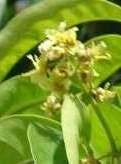Tulip lancewood
(Harpullia pendula)

Description
Harpullia pendula, known as the tulipwood or tulip lancewood is a small to medium-sized rainforest tree from Australia. The tree's small size, pleasant form and attractive fruit ensures the popularity of this ornamental tree. The range of natural distribution is from the Bellinger River in northern New South Wales to Coen in tropical Queensland. Tulipwood occurs in various types of rainforest, by streams or dry rainforests on basaltic or alluvial soils. In tropical and sub tropical rainforest. Often seen as a street tree, such as at St Ives, New South Wales. A medium-sized tree, up to 24 metres tall and a stem diameter of 60 cm. Usually seen much smaller. As a street tree, it's mostly under 6 metres tall with an attractive and shapely crown. The trunk is irregular in shape, often fluted. Bark is grey and scaly. Harpullia is a genus of about 27 species of small to medium-sized rainforest trees from the family Sapindaceae. They have a wide distribution ranging from India eastwards through Malesia, Papuasia and Australasia to the Pacific Islands. They grow naturally usually in or on the margins of rainforests or associated vegetation. The major centre of diversity, of about twenty species, occurs throughout New Guinea including its surrounding islands and region. Australia harbours another centre of smaller diversity, of about eight species, growing naturally from northeastern New South Wales through eastern Queensland to Cape York Peninsula and coastal Northern Territory. Of the eight Harpullia species which grow naturally Australia six occur only (endemic) in Australia. They have the common name tulipwoods and were prized for their dark coloured timber. The one most commonly known to Australian horticulture is Harpullia pendula which is widely planted as a street tree along the east coast. H. frutescens is a small shrub with horticultural potential. European science formally published the name and description of this genus and its H. cupanioides type specimen from India, in 1824, authored by Scottish botanist William Roxburgh. The genus name, Harpullia, derives from "Harpulli, "the vernacular name at Chittagong". Recently in 2011 Japanese–American botanist Wayne Takeuchi formally published the name and description of H. mabberleyana, the "first member of the genus to be discovered in New Guinea since 1940".
Taxonomic tree:







